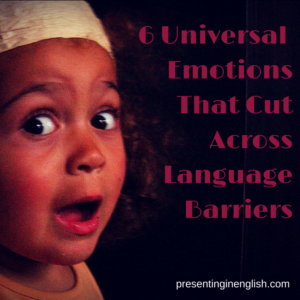
In order to truly connect with your audience, you need to empathise with your audience. You need to understand how the audience feels. Your key message needs to convey the idea that “I’ve been there, I understand how you feel, I can relate to your experience.” In order to build this empathy with your audience you can rely on the six universal emotions: happiness, sadness, surprise, anger, disgust and fear. These are emotions that everyone, no matter their native language, has experienced at some point in their lives. As an ESL speaker you can use these universal emotions to build your connection with the audience.
As we discussed earlier this week, stories are a great tool for ESL speakers to connect with their audience. However, emotions don’t just have to be shared through stories. Shocking facts, statistics and information can also provoke an emotional reaction from your audience, although it is more difficult. Here are some suggestions and examples of how to include each emotion in your presentation.
Happiness
Why do people watch romantic comedy films, if they always know what will happen in the end? Because they enjoy that warm, happy feeling knowing that everything will be just fine in the end. Sharing this emotion with your audience is powerful. Lots of motivational speakers tap into this emotion or the desire to be happy to captivate their audiences. Happiness is an emotion that is appropriate for almost every presentation or situation.
For example: A story about your new habit of meditating that brings a sense of peace and happiness to your life everyday. This story can be used to convey the message that your audience can also find happiness through mediation.
For example: Tell the audience of how much their charitable donations have contributed towards the financial goal. Tell them a story of someone who is being helped by their donations. Both of these options are bound to create a feeling of happiness.
Sadness
We’ve all been there. Cried for someone lost, a missed opportunity, a failed romance, or just a bad day. Sharing a personal moment of sadness with the audience shows that you are vulnerable and human. This establishes empathy and credible. Sharing this emotion with an audience may not be right for all occasions; however, the negativity bias shows that something very negative will generally have more of an impact on a person’s behavior than something equally emotional but positive.
For example: Sharing information about the deforestation of the rainforest and the extinction of a species could provoke sadness in the audience. After you have captured the audience’s attention with this emotion, you can develop a message of how we could change this situation and protect the rainforests.
Surprise
One of the best places to make the audience feel surprised is in humourous moments. You make the audience laugh by telling a joke or a story with an unexpected twist. When we are surprised we are entertained. However, a surprise doesn’t have to be funny it can also be serious. An unexpected outcome in a situation can be an opportunity for learning and sharing this with the audience can help them advance their learning.
For example: Tell a joke about trying to communicate with your mother-in-law in another language. Begin by explaining how much effort you were making, then talk about how you were improving, then deliver the twist that you confused two similar words and swore at your mother-in-law.
Anger
This anger can be directed at someone, something or even yourself. Craig Valentine, the 1999 World Champion of Public Speaking, suggests that you can connect with you audience through the 4Fs: your firsts, your flaws, your failures and your frustrations. Both your failures and your frustrations can include the emotion of anger.
For example: Maybe you failed at winning a competition and you were angry at yourself for not preparing more. Then after trying again several times you finally managed to win. This classic message of perseverance begins with anger towards yourself.
Disgust
This emotion may not be appropriate for all situations, but can be effective if you are trying to persuade of your opinion on something. Sharing how much hate or dislike something with passion can evoke this emotion in your audience.
For example: Do you find the way animals are treated inhumane? Try to get the audience to have a feeling of disgust about the treatment of animals on commercial farms to support your message.
Fear
Are you scared of something? Most of us are. Sharing your fears creates that empathy with your audience, especially if they have the same fears. You can build on this by also sharing how you overcame this fear for a very powerful presentation. Creating the emotion of fear in the audience can also mean scaring the audience with disturbing or shocking facts and statistics.
For example: Sharing your fear of public speaking when you were younger in your introduction can create credibility with the audience. The audience may think, ‘Well if she overcame her nervousness, so can I.’
For example: Giving a presentation that begins with shocking statistics about obesity in the United Kingdom can cause the audience to be scared about their diets.
